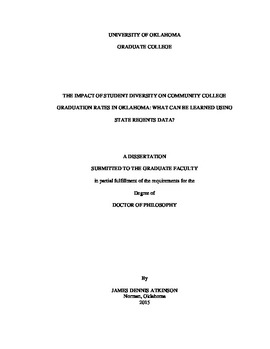| dc.contributor.advisor | Tan, David | |
| dc.contributor.author | Atkinson, James | |
| dc.date.accessioned | 2016-04-15T13:34:30Z | |
| dc.date.available | 2016-04-15T13:34:30Z | |
| dc.date.issued | 2015-12-18 | |
| dc.identifier.uri | https://hdl.handle.net/11244/33382 | |
| dc.description.abstract | The United States federal government requires postsecondary schools, including community colleges, to calculate student completion rates and make them public information, which they do through the Integrated Postsecondary Education Data System (IPEDS). Stakeholders are keenly interested in completion rates as a measure of community college quality. Community colleges’ mission compels them to admit nearly every student desiring an opportunity to earn a higher education credential. This policy results in great diversity among students in their academic preparedness and their propensity to complete a college program. Using discrete student records from Oklahoma’s public two-year colleges, this research project seeks to determine how much of the difference in completion rates is attributable to diversity in the background of admitted students. | en_US |
| dc.language | en_US | en_US |
| dc.subject | community colleges, graduation rates, educational policy, accountability measures | en_US |
| dc.title | THE IMPACT OF STUDENT DIVERSITY ON COMMUNITY COLLEGE GRADUATION RATES IN OKLAHOMA: WHAT CAN BE LEARNED USING STATE REGENTS DATA? | en_US |
| dc.date.manuscript | 2015-12-16 | |
| dc.thesis.degree | Ph.D. | en_US |
| ou.group | Jeannine Rainbolt College of Education::Department of Educational Psychology | en_US |
